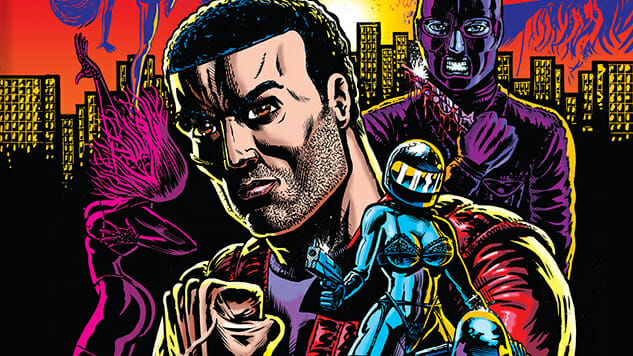“Beauty is the Lowest Common Denominator”: Benjamin Marra on Night Business
Also: Giotto, Dario Argento and Lampooning Hyper-Masculinty

The cover of Ben Marra’s Night Business portrays a woman in lingerie astride a motorcycle brandishing a handgun, a stubbled man flexing a fist, a stripper flipping her hair and a creep in a full-face leather mask holding a bloody knife. It’s also one of the mildest covers the Toronto-based cartoonist has ever produced. In contrast, Marra’s previous exploitation odds-and-ends collection, American Blood, features a testosterone-gushing man’s fist flying through another man’s face, and the graphic novel Terror Assaulter: O.M.W.O.T. has its grizzled anti-hero beheading a villain (who’s holding a chainsaw) with a sword. Night Business is less openly absurd than some of the auteur’s previous works, and less obviously satirical, but it clearly reflects the same obsessions that have marked Marra’s career. What kind of a person would focus on this bottom-shelf, grindhouse imagery, stemming from the B-movie ‘80s underground? A gore-crazed shut-in, his walls lined with clamshell VHS tapes? Maybe, but Marra, also a Paste Songs Illustrated veteran, seems like a pretty nice guy [Ed.: He is!]. Paste tried to pry open his brain to see what inspires the sex-and-violence melange that occupies his books.
A soft NSFW warning for the preview art displayed below.![]()
Paste: You studied at the School for Visual Arts (SVA) in New York, right? Did you take any classes with David Sandlin ? I feel like I can see a bit of his influence in your work.
Ben Marra: I went to SVA for grad school. I did indeed have David Sandlin as a professor for my thesis class and I took a silkscreen bookmaking class he taught as well. I never have included him as an influence, though I love his work. He was definitely an influential force on my comic book efforts. I feel like he was one of the first professors I had who actively supported and encouraged me to make comics. Funny that he was one of the last professors I had in my education.
Paste: And then you went to Florence to study painting? Was that as part of a program or just on your own?
Marra: I went to Florence before I attended SVA. It was during my undergrad years at Syracuse University. Syracuse has a satellite school in Florence and it was one of the reasons I chose to go to Syracuse. I knew I’d want to go to Florence my junior year.

Night Business Cover Art by Benjamin Marra
Paste: You know, Ben Hatke went and studied there, too. It doesn’t seem like artists do that much these days. What led you there, and what did you do while you were there?
Marra: I wanted to make the most out of my education and my time in school. There aren’t many opportunities to study art in Italy after you’re out of school and have a job. When you’re young, you have time for such pursuits, and I took advantage. I studied drawing and painting while I was in Italy. My classmates and I drew and painted constantly. I had a few breakthroughs. I took several fine arts classes and art history classes. We’d go on field trips to various cities to look at frescos and sculpture. Seeing that stuff in person really hits you. It’s a profound experience. It really changed me and the way I thought about making art.
Paste: I definitely see a preoccupation with human anatomy in your work, although not necessarily with trying to make it super accurate. It’s more like Michelangelo, in that the dudes are pretty lumpy with someone’s idea of muscle. Would you say you’re influenced by the Old Masters? Who’s your favorite?
Marra: I would say I am indeed influenced by the Old Masters. But it’s less about how they represent the human form or anatomy and more about capturing and communicating a feeling. I’m not influenced by Michelangelo or any of the High Renaissance artists. In fact, I think that stuff is kind of boring. I think Michelangelo’s David is probably the greatest work of art any human has ever created because of its sheer impossibleness, but my artistic ambitions aren’t about replicating reality or creating beautiful things. Beauty is common. Beauty is the lowest common denominator. Everyone can appreciate beauty. What’s the challenge in that? My favorites of the Old Masters operated in the Middle Ages or Pre-Renaissance. Seeing and studying Giotto’s work was probably the single biggest shift in my perception of art and what I would try to do with drawing and telling stories. Giotto’s struggle with his limitations as an artist did not stop him from creating. I find that incredibly inspiring. His work is about figuring things out, not success. The success comes from the attempt.
For instance, perspective in drawing had not been discovered yet, so all his buildings jut out at different angles, clustered together as cities. My favorite is Piero della Francesca, because his art is so strange and mysterious. His figures are stiff, even cold and empty. His devotion and attention in his work are not overlabored. They stick in my mind and never leave. I find the attitudes toward creation of these two painters endlessly inspiring.

Night Business Interior Art by Benjamin Marra
-

-

-

-

-

-

-

-

-

-

-

-

-

-

-

-

-

-

-

-

-

-

-

-

-

-

-

-

-

-

-

-

-

-

-

-

-

-

-

-












































